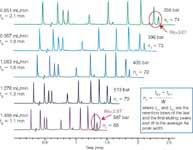Fast, Low Pressure Analysis of Food and Beverage Additives Using Agilent Poroshell 120
Agilent Technologies Application Note
Anne E. Mack and William J. Long, Agilent Technologies Inc., Wilmington, Delaware, USA.
Agilent Poroshell 120, a superficially porous particle column, offers resolution and speed similar to columns packed with 1.8 µm totally porous particles, without generating high back pressure. The high efficiency of Poroshell 120 particles is due to short mass transfer distance and substantially narrower particle size distribution. The larger 2.7 µm Poroshell 120 particles generate very low back pressure, about 40–60% of sub-2 µm totally porous particles. This allows the columns to run at faster flow rates without exceeding HPLC pressures. Poroshell 120 columns with 2 µm frits are more forgiving with dirty samples than 1.8 µm columns, providing a more seamless method transfer from traditional 5 µm columns.
A group of 11 non-nutritive food and beverage additives are used to demonstrate this method translation. These compounds include preservatives, artificial sweeteners, an energy supplement and a flavouring agent.
Results and Discussion
Figure 1 shows an overlay of the original 250 mm, 5 µm method compared to the new 100 mm Poroshell 120 method. Flow rate for the Poroshell 120 column is adjusted to compensate for the smaller column i.d. and particle size, while gradient time is scaled proportionally. Analysis time is reduced by 80% — from 13.1 to 2.6 min — with the post run time reduced from 7 to 1.8 min. Solvent and mobile phase consumption are also reduced by more than 80%. Resolution of critical pair (dehydroacetic acid and methylparaben) improved from 1.79 to 3.01 on Poroshell 120, compared to the longer 5 µm Eclipse Plus method. Note in Figure 1, that the last peak on Poroshell 120 elutes at approximately the same time as the first peak on 5 µm Eclipse Plus.

Figure 1: Fast, low pressure analysis; all 11 peaks on Poroshell 120 are resolved by the time the first peak elutes on the original 5 µm Eclipse plus method.
When high throughput is most important and HPLC system limits allow, flow rate can be increased with little loss in chromatographic quality, as shown in Figure 2. Flow rate on the 3.0 × 100 mm Poroshell 120 column can be increased from 0.851 to 1.489 mL/min to further reduce run time by 40% in under 600 bar. This achieves little loss in resolution of the critical pair and has a minimal effect on conditional peak capacity (nc). The result is a baseline separation of 11 compounds in 1.5 min, in under 600 bar.

Figure 2: Flow rate on Poroshell 120 can be increased to further enhance productivity with minimal impact on resolution and conditional peak capacity (nc).
Conclusion
Due to the similar selectivity between Poroshell 120 EC-C18 and Eclipse Plus C18, methods can easily be transferred from older Eclipse Plus C18 columns to new Poroshell 120 EC-C18 columns. Methods developed on Poroshell 120 can be transferred to 600 bar instruments for even greater productivity gains. More details of this analysis are found on the Agilent website; search for the full-length version of this application note using publication #5990-6082EN.

Agilent Technologies Inc.
2850 Centerville Road, Wilmington, Delaware 19808, USA
tel. +1 800 227 9770 fax +1 302 633 8901

Analytical Challenges in Measuring Migration from Food Contact Materials
November 2nd 2015Food contact materials contain low molecular weight additives and processing aids which can migrate into foods leading to trace levels of contamination. Food safety is ensured through regulations, comprising compositional controls and migration limits, which present a significant analytical challenge to the food industry to ensure compliance and demonstrate due diligence. Of the various analytical approaches, LC-MS/MS has proved to be an essential tool in monitoring migration of target compounds into foods, and more sophisticated approaches such as LC-high resolution MS (Orbitrap) are being increasingly used for untargeted analysis to monitor non-intentionally added substances. This podcast will provide an overview to this area, illustrated with various applications showing current approaches being employed.

















